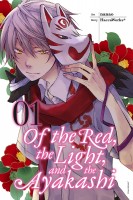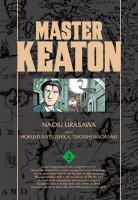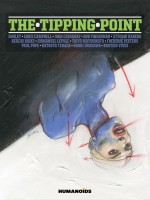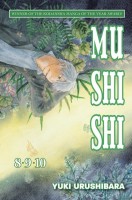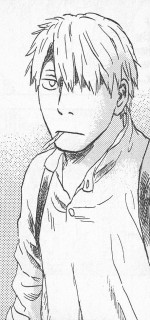My News and Reviews
I only posted one in-depth manga review at Experiments in Manga last week, taking a look at Of the Red, the Light, and the Ayakashi, Volume 1 by Nanao, which is an adaptation of a visual novel by the doujin group HaccaWorks*. I was actually a little surprised by how much I enjoyed the manga. Though I can imagine the series getting tiresome if at least some answers to story’s many mysteries aren’t given soon, at the moment I’m intensely intrigued. I think I’m finally starting to come to terms with the fact that much of the time I can only manage one review per week right now, though I’d honestly love to do more reading and writing. I also want to quickly follow-up on a statement that I made in the Bookshelf Overload for February—I mentioned that I wasn’t sure if Keigo Higashino’s novel Under the Midnight Sun would be released in the United States or not, but it turns out that it will be! The United Kingdom simply got it first, which is sometimes what happens with works in translation.
In other licensing news, several manga publishers made announcements over the course of last week and the weekend. Kodansha Comics will be releasing twelve new titles in print, some of which I find to be particularly exciting or intriguing (the Parasyte shoujo anthology, shounen ballroom dancing, single fathers learning to cook, and more!). Among other things Viz Media will be publishing a new deluxe edition of Junji Ito’s Tomie (which has gone out of print at least twice before from two other publishers) and will continue releasing more of the fancy JoJo’s Bizarre Adventure hardcovers. Yen Press announce seven print manga licenses, two of which were previously part of its digital manga catalog. (This gives me hope that one day, however unlikely, it could be possible to see Saki in print.) Finally, Sekai Project, is expanding its manga efforts by licensing Suzunone Rena’s Sakura Spirit manga adaptation. (Also, the first two volumes of the publisher’s debut manga, Gate, are now available for preorder.) I also came across a couple of interviews last week that were interesting: the Shojo Beat tumblr posted the second part of its interview with Arina Tanemura and Anime News Network has an interview with Inio Asano.
Quick Takes
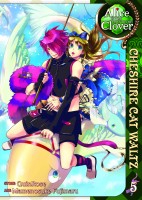 Alice in the Country of Clover: Cheshire Cat Waltz, Volumes 5-7 by Mamenosuke Fujimaru. Overall, I must say that I rather enjoyed Cheshire Cat Waltz. It’s only the second followup to the original Alice in the Country of Hearts manga that I’ve read, but I liked how it expanded the story, characters, and world of the franchise. Cheshire Cat Waltz features two tangentially related storylines. The first is the romance between Alice and Boris which by now is well established even though she’s still working through some self-doubt. Their relationship actually ends up being rather sweet. One of the running themes in the various Alice in the Country of manga is that Alice’s very presence changes the others in Wonderland; Boris certainly has become a better person over time. The second major storyline in Cheshire Cat Waltz has to do with the mob war in which Alice unwittingly becomes embroiled in due to her association with the Hatter’s mafia family. These last few volumes of Cheshire Cat Waltz also include an Alice in the Country of Hearts story which features Boris as Alice’s romantic interest as well.
Alice in the Country of Clover: Cheshire Cat Waltz, Volumes 5-7 by Mamenosuke Fujimaru. Overall, I must say that I rather enjoyed Cheshire Cat Waltz. It’s only the second followup to the original Alice in the Country of Hearts manga that I’ve read, but I liked how it expanded the story, characters, and world of the franchise. Cheshire Cat Waltz features two tangentially related storylines. The first is the romance between Alice and Boris which by now is well established even though she’s still working through some self-doubt. Their relationship actually ends up being rather sweet. One of the running themes in the various Alice in the Country of manga is that Alice’s very presence changes the others in Wonderland; Boris certainly has become a better person over time. The second major storyline in Cheshire Cat Waltz has to do with the mob war in which Alice unwittingly becomes embroiled in due to her association with the Hatter’s mafia family. These last few volumes of Cheshire Cat Waltz also include an Alice in the Country of Hearts story which features Boris as Alice’s romantic interest as well.
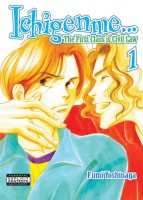 Ichigenme… The First Class is Civil Law, Volumes 1-2 by Fumi Yoshinaga. Out of all of Yoshinaga’s boys’ love manga that have been released in English, I believe that Ichigenme may very well be one of the most explicit. Like many of her other two-volume series, it does take its time getting there, though. The first volume of Ichigenme is mostly focused on introducing the various characters and their evolving relationships. The leads of the manga are two law students who happen to join the same seminar—the particularly bright and honest Tamiya, who’s in the process of coming to terms with his homosexuality, and the openly gay Tohdou, a seemingly carefree son of a politician. The second volume, which is actually set seven years later after the first, more fully explores the developments in their physical relationship. What I particularly appreciate about all of the sex in Ichigenme is that it isn’t just sex for sex’s sake—Yoshinaga uses it to delve into the character’s themselves, revealing parts of their thoughts, feelings, and personalities through their intimacy with each other.
Ichigenme… The First Class is Civil Law, Volumes 1-2 by Fumi Yoshinaga. Out of all of Yoshinaga’s boys’ love manga that have been released in English, I believe that Ichigenme may very well be one of the most explicit. Like many of her other two-volume series, it does take its time getting there, though. The first volume of Ichigenme is mostly focused on introducing the various characters and their evolving relationships. The leads of the manga are two law students who happen to join the same seminar—the particularly bright and honest Tamiya, who’s in the process of coming to terms with his homosexuality, and the openly gay Tohdou, a seemingly carefree son of a politician. The second volume, which is actually set seven years later after the first, more fully explores the developments in their physical relationship. What I particularly appreciate about all of the sex in Ichigenme is that it isn’t just sex for sex’s sake—Yoshinaga uses it to delve into the character’s themselves, revealing parts of their thoughts, feelings, and personalities through their intimacy with each other.
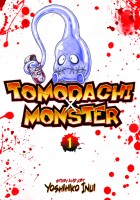 Tomodachi x Monster, Volume 1 by Yoshihiko Inui. I’ve heard Tomodachi x Monster described as a dark parody, but after reading the first volume, I’m not sure how accurate that really is. The humor that I would expect seems to be missing (granted, parody doesn’t necessarily mean comedy), but the darkness is certainly there—Tomodachi x Monster is what you get when you take a series like Pokémon and turn it into a bizarre horror manga accompanied by heavy doses of violence and gore. Confrontations between middle school students become much more dangerous and deadly when their little monster pals inflict extraordinary amounts of damage and pain. Characters start dying off surprisingly quickly in Tomodachi x Monster, generally in some sort of gruesome fashion. The series can be pretty ridiculous and over-the-top with its violence. While the art style tends towards creepy-cute designs, some of the most effective imagery in the manga is legitimately disturbing. The mental states of most of the characters are perhaps even more terrifying, though.
Tomodachi x Monster, Volume 1 by Yoshihiko Inui. I’ve heard Tomodachi x Monster described as a dark parody, but after reading the first volume, I’m not sure how accurate that really is. The humor that I would expect seems to be missing (granted, parody doesn’t necessarily mean comedy), but the darkness is certainly there—Tomodachi x Monster is what you get when you take a series like Pokémon and turn it into a bizarre horror manga accompanied by heavy doses of violence and gore. Confrontations between middle school students become much more dangerous and deadly when their little monster pals inflict extraordinary amounts of damage and pain. Characters start dying off surprisingly quickly in Tomodachi x Monster, generally in some sort of gruesome fashion. The series can be pretty ridiculous and over-the-top with its violence. While the art style tends towards creepy-cute designs, some of the most effective imagery in the manga is legitimately disturbing. The mental states of most of the characters are perhaps even more terrifying, though.

